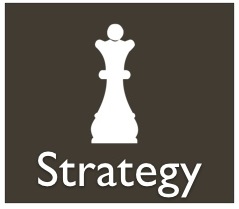Even the best research is only valuable if it drives smart, strategic decisions.
That’s where I come in.
I transform research findings into actionable strategy — helping teams define their goals, understand their audiences, and prioritize the most meaningful tasks. The outcome is a clear, user-centered roadmap that balances business objectives with audience needs and makes everything downstream — from IA to content to design — easier and more effective.
Balancing Business Goals and User Needs
Every successful site or app is a mediation between two forces:
What the business wants to achieve (push)
What the user needs to accomplish (pull)
Great digital strategy aligns these forces. It builds a fulcrum that supports both sides.
Defining Business Goals
Strategy starts with clarity: Why does this site or app exist?
Too often, I’ve been brought in to “refresh a website” or “modernize a platform” — without a clear understanding of the why. That’s where trouble begins. Digital investments must be anchored in measurable business goals. These usually fall into three categories:
Revenue Generation – Sell products, services, or generate qualified leads
Cost Reduction – Reduce call center volume, sales costs, or overhead
Brand Visibility – Strengthen digital brand presence and extend market reach
Prioritization & Metrics
Once goals are articulated, we must prioritize them and define success. This allows every IA, design, and content decision to ladder up to real business impact.
Example metric:
“Increase self-scheduled appointments by 35% in six months”
Defining measurable goals gives us a clear benchmark for ROI — and keeps teams aligned.
Customer Needs, Preferences, Personas & Journeys
Customer Segments are built by analyzing trends in site user demographics, psychographics, firmographics and behaviors.
Creating Customer Segments
Using demographic, psychographic, firmographic, and behavioral data, I uncover natural groupings in your audience. These segments clarify who you’re really serving — and what matters most to each group.
Well-defined segments drive personalization, relevance, and efficiency across content and UX.
A sample of a Persona created for a Client
Personas
To bring those segments to life, I develop personas — humanized composites that reflect motivations, behaviors, and pain points. Giving each persona a name and face helps teams empathize, prioritize, and stay grounded in the audience’s experience.
Real example: “We can’t forget Mathilda!”
It’s a phrase I’ve heard — and said — more than once in client strategy sessions.
A Journey Map for the Persona I created
Mapping Customer Journeys
Personas are only part of the picture. We also need to understand how they move through your digital experience.
I create journey maps and scenario flows to visualize key user tasks — from discovery to conversion. These narratives reveal friction points, highlight opportunities, and set the stage for interface design.
Example:
“Rika is looking for a primary care doctor. She starts with a Google search, sees a paid ad, lands on a hospital homepage, and uses the ‘Find a Physician’ tool...”
Mapping these steps helps us design with intent and empathy.
User process flows and scenarios usually take the basic form of the figure above.
Task Prioritization Across the Ecosystem
Next, I consolidate all identified user scenarios and create a master task inventory. This is then prioritized by:
Business value
Segment-specific urgency
Frequency and complexity
This prioritized list ensures your IA and content strategy align with what matters most to both users and stakeholders.
Feature / Function Analysis
Traceability Matrix
To connect the dots between research findings and design recommendations, I build a traceability matrix — a feature/function analysis that ensures:
Every recommendation aligns with a user or business need
Opportunities are benchmarked against competitors
Technical feasibility is documented
The result: Strategic clarity + execution alignment.
Feature / Function Analysis: the best way of ensuring all recommendations are based on and prioritized by business goals and user needs.
Strategy Recommendations
Strategy isn’t just something I deliver — it’s something I help teams experience. I present findings and recommendations in collaborative sessions designed to build shared understanding before IA and design begin.
Whether it’s a written strategy document, a live presentation, or a working session, the goal is always the same:
Make sure everyone is aligned, inspired, and moving in the same direction.


